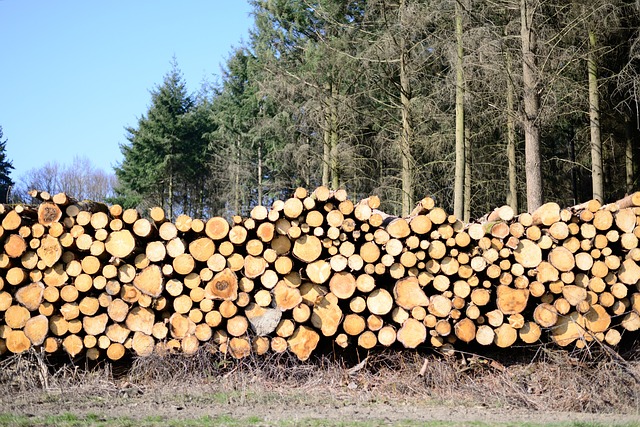If you’ve ever wondered whether fir wood is a good firewood choice for your fireplace or wood-burning stove, you’ve come to the right place.
Yes, fir is generally considered good firewood. It offers a decent heat output, ignites easily, and burns steadily. Fir wood, including species like red fir, white fir, Douglas fir, grand fir, and balsam fir, can provide a reliable source of warmth for your fireplace or wood-burning stove. However, it’s important to properly season and store fir wood to optimize its burning performance.
In this article, I’ll delve into the burning qualities of different fir species, including red fir, white fir, Douglas fir, grand fir, and balsam fir. By the end, you’ll have a clearer understanding of whether fir wood is good firewood.
Fir wood is no stranger to us—it’s widely used in construction and furniture due to its strength and versatility. But when it comes to using it as firewood, there are a few factors to consider. Let’s explore the burning potential of fir wood.
Understanding the Characteristics of Fir Wood
When it comes to understanding the characteristics of fir wood, it’s important to know what sets it apart from other types of firewood. Let’s dive into the details!
Fir wood is known for its durability and strength, which makes it popular for construction purposes. It is commonly used in building frames, furniture, and even as a material for doors and windows. These properties stem from its high density and the tightness of its growth rings, resulting in a sturdy and reliable wood.
Now, let’s talk about the different species of fir wood commonly used for firewood. There’s red fir, white fir, Douglas fir, grand fir, and balsam fir. Each of these species has its own unique characteristics that influence their performance as firewood.
Red fir, also known as noble fir, is a popular choice for Christmas trees due to its beautiful appearance. It has moderate density and offers a good heat output when used as firewood. White fir, on the other hand, is slightly less dense than red fir but still provides a decent amount of heat.
Douglas fir is a well-known species, highly regarded for its strength and versatility. It has a higher density compared to red and white fir, which means it can produce a longer-lasting fire. If you’re looking for a species that offers a combination of heat output and durability, Douglas fir is worth considering.
Grand fir, often used for its pleasant fragrance in the form of wreaths and garlands, can also serve as firewood. It has a moderate density and produces a nice aroma when burned. Lastly, balsam fir, another popular Christmas tree choice, has similar burning qualities to other fir species, providing a good amount of heat.
In summary, fir wood as a whole is known for its strength and durability. When it comes to firewood, different species of fir have varying densities and heat output. The choice of which fir species to use ultimately depends on your specific heating needs and preferences. Let’s explore this further!
Evaluating the Burning Qualities of Fir Wood
Now that you have a better understanding of the characteristics of fir wood, let’s dive into evaluating its burning qualities. This will help you determine if fir wood is indeed good firewood for your need.
Heating Value
One crucial aspect to consider is the heating value of fir wood. It refers to the amount of heat produced when the wood is burned. Fir wood, including species like red fir, white fir, Douglas fir, grand fir, and balsam fir, generally offers a moderate to high heating value. This means they can generate a substantial amount of warmth and keep your space cozy during those chilly nights.
Ignition and Combustion
When it comes to starting a fire, the ease of ignition and combustion rate are essential factors. Fir wood tends to ignite relatively easily, making it convenient for lighting your fireplace or stove. Once the fire is established, fir wood typically burns steadily and consistently, providing a reliable heat source. The burn rate may vary slightly among different fir species, but overall, fir wood is known for its steady and reliable combustion.
Smoke and Creosote Production
Excessive smoke and creosote buildup can be problematic when using firewood. Fortunately, fir wood generally produces minimal smoke, making it a favorable choice for those who prefer a cleaner burn. However, it’s important to note that burning any wood can lead to the production of creosote, a flammable substance that can accumulate in the chimney. Regular chimney maintenance and cleaning are crucial to prevent creosote buildup and ensure safe and efficient burning.
By evaluating the heating value, ignition and combustion characteristics, as well as smoke and creosote production, we can conclude that fir wood, including red fir, white fir, Douglas fir, grand fir, and balsam fir, generally exhibit good burning qualities. They offer a decent heat output, ignite easily, burn steadily, and produce minimal smoke. However, it’s important to remember that the quality of the firewood can also be influenced by factors like moisture content and proper seasoning.
In the next section, I’ll explore the pros and cons of using fir wood as firewood, providing you with a comprehensive overview to help you make an informed decision.
Pros and Cons of Using Fir Wood as Firewood
Using fir wood as firewood comes with its own set of advantages and considerations. Let’s delve into the pros and cons to help you make an informed decision.
Pros of Using Fir Wood as Firewood
- Availability: Fir trees are widely distributed, making fir wood readily available in many regions. This accessibility means you can often find a local source for your firewood needs.
- Affordability: Due to its availability and widespread use, fir wood is generally more affordable compared to some other types of firewood. This can be particularly appealing if you’re looking for a cost-effective option to keep your fireplace or stove burning.
- Decent Heat Output: Fir wood, including red fir, white fir, Douglas fir, grand fir, and balsam fir, offers a good heat output. This means you can enjoy a warm and cozy fire that efficiently heats your space.
- Pleasant Aroma: Many fir species have a pleasant aroma when burned. If you appreciate the scent of wood smoke, using fir wood can enhance the ambiance and add a delightful fragrance to your indoor or outdoor fire.
Cons of Using Fir Wood as Firewood
- Ash Production: Fir wood tends to produce more ash compared to some hardwoods. While ash can be beneficial for garden soil enrichment, frequent ash removal may be required to maintain optimal firebox and chimney performance.
- Seasoning Requirements: Like any firewood, fir wood needs to be properly seasoned to achieve optimal burning performance. It has a higher moisture content when freshly cut, so allowing it to dry for an adequate period is crucial. Improperly seasoned fir wood can lead to inefficient burning, increased smoke production, and creosote buildup.
- Storage Challenges: Fir wood should be stored in a dry and well-ventilated area to prevent moisture absorption. Moisture can affect its burning qualities and make it more challenging to ignite. Ensure your storage space protects the wood from rain, snow, and ground moisture while allowing proper airflow.
- Creosote Buildup: Although fir wood generally produces minimal smoke, it is still important to be mindful of creosote buildup in your chimney. Regular chimney cleaning and inspections are essential to maintain safe and efficient burning.
Remember, proper seasoning, storage, and maintenance practices are crucial for getting the best performance out of your fir firewood.
Next, I’ll explore some best practices for burning fir wood, including tips on seasoning, storage, and safety measures.
Best Practices for Burning Fir Wood
To ensure optimal burning performance and safety when using fir wood as firewood, it’s important to follow some best practices. Let’s explore the key considerations for seasoning, storage, and maintaining a safe burning environment:
1. Seasoning and Drying
- Properly season fir wood before using it as firewood. Freshly cut fir wood typically has a high moisture content, which can hinder its burning efficiency. Aim for a moisture content of around 15-20% for optimal burning.
- Split the wood into smaller pieces to facilitate faster and more even drying. This increases the surface area and promotes airflow, helping the wood dry more effectively.
- Allow the wood to season in a dry and well-ventilated area for at least 6-12 months. This duration may vary depending on the climate and moisture content of the wood when initially cut.
2. Storage Considerations
- Choose a dry and covered storage location for your fir wood. Ideally, it should be protected from rain, snow, and ground moisture. A woodshed or covered area with good ventilation is ideal.
- Stack the wood off the ground using pallets or other supports to prevent moisture absorption from the soil.
- Ensure proper airflow around the stacked wood to facilitate continued drying and prevent mold or rot.
3. Maintenance and Safety
- Regularly inspect and clean your chimney to minimize the risk of creosote buildup, which can lead to chimney fires. It’s recommended to have a professional chimney sweep perform a thorough cleaning annually.
- Use a spark arrestor or chimney cap to prevent sparks and embers from escaping and potentially causing a fire hazard.
- Follow all safety guidelines and regulations when operating your fireplace or wood-burning stove. This includes using a fireplace screen, keeping flammable materials away from the fire, and using appropriate safety equipment such as heat-resistant gloves and fire extinguishers.
Properly seasoned and stored fir wood will provide a cleaner burn with minimal smoke production. experience.
Conclusion
In conclusion, fir wood, including species like red fir, white fir, Douglas fir, grand fir, and balsam fir, can be good firewood with its unique characteristics and burning qualities. It offers a decent heat output, ignites easily, and burns steadily, providing a reliable source of warmth for your fireplace or wood-burning stove.
When considering fir wood as firewood, it’s important to weigh the pros and cons. Fir wood is readily available, and affordable, and often comes with a pleasant aroma when burned. However, it does produce more ash and requires proper seasoning and storage to optimize its burning performance.
By following best practices such as properly seasoning the wood, storing it in a dry and well-ventilated area, and maintaining your chimney, you can ensure the best burning experience with fir wood. Regular maintenance and adherence to safety guidelines will contribute to a safe and efficient fire environment.
Remember, the choice of firewood ultimately depends on your specific heating needs, availability, and personal preferences. Whether you decide to use fir wood or explore other options, prioritizing safety and proper burning practices should always be at the forefront of your mind.
Now, armed with the knowledge of fir wood’s burning potential, go ahead and enjoy the crackling ambiance and cozy warmth of your fires. Stay warm, stay safe, and embrace the joys of a well-burning fire!
Happy burning!










